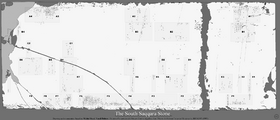South Saqqara Stone facts for kids
The South Saqqara Stone is a large piece of stone. Written on the stone is a list of the pharaohs of the 6th dynasty of ancient Egypt. The list includes Teti, Userkare, Pepi I, Merenre and Pepi II. The list finishes with Pepi II which means it was probably written during his rule. The list is a record of the events which took place during each kings rule. However the stone was used later as the lid of sarcophagus. This was for the burial of the ancient Egyptian queen Ankhenespepi. A lot of the writing can not be read any longer.
Contents
Discovery
The South Saqqara Stone was discovered in 1932-33 by Gustave Jéquier. It was in a storeroom, south of the pyramid of Queen Iput II. This is part of the pyramid complex of Pepi II at Saqqara. Saqqara was the main burial area for the city of Memphis.
Description
The stone is a piece of basalt, 2.43 metres by 0.92 metres and 20 centimetres thick. It has writing on both sides, but much of the writing has been removed and is unreadable.
Significance
The writing on the South Saqqara Stone means it is an important object. The list of pharaohs has details about the annual or biannual cattle count. This matches details in other lists such as the Turin King List. This allows archaeologists to work out how long each king ruled. From the information on the stone it can be worked out that Teti ruled for at least 12 years, Userkare 2-4 years, Pepi I 49-50 years and 11-13 years for Merenre.
The Stone is one of the earliest historical documents in existence. It has the names of all the pharaohs known to the people who made it.
Related pages
- Michel Baud, Vassil Dobrev, De nouvelles annales de l'Ancien Empire égyptien. Une "Pierre de Palerme" pour la VIe dynastie, BIFAO 95 (1995), pp.23-92


